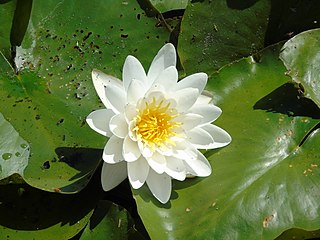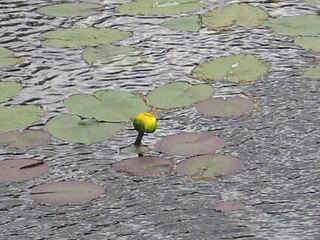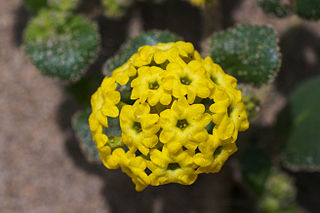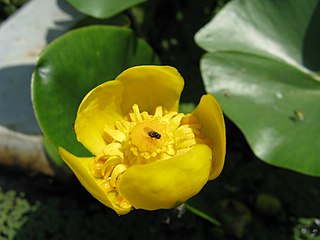
Nymphaeaceae is a family of flowering plants, commonly called water lilies. They live as rhizomatous aquatic herbs in temperate and tropical climates around the world. The family contains five genera with about 70 known species. Water lilies are rooted in soil in bodies of water, with leaves and flowers floating on or emergent from the surface. Leaves are round, with a radial notch in Nymphaea and Nuphar, but fully circular in Victoria and Euryale.

Nymphaea is a genus of hardy and tender aquatic plants in the family Nymphaeaceae. The genus has a cosmopolitan distribution. Many species are cultivated as ornamental plants, and many cultivars have been bred. Some taxa occur as introduced species where they are not native, and some are weeds. Plants of the genus are known commonly as water lilies, or waterlilies in the United Kingdom. The genus name is from the Greek νυμφαία, nymphaia and the Latin nymphaea, which mean "water lily" and were inspired by the nymphs of Greek and Latin mythology.

Nuphar is a genus of aquatic plants in the family Nymphaeaceae, with a temperate to subarctic Northern Hemisphere distribution. Common names include water-lily, pond-lily, alligator-bonnet or bonnet lily, and spatterdock.

Nuphar lutea, the yellow water-lily, brandy-bottle, or spadderdock, is an aquatic plant of the family Nymphaeaceae, native to northern temperate and some subtropical regions of Europe, northwest Africa, western Asia, North America, and Cuba. This interesting species found on both sides of the Atlantic Ocean was used as a food source and in medicinal practices from prehistoric times with potential research and medical applications going forward.
Yellow waterlily is a common name for several plants and may refer to:

Nuphar advena is a species of Nuphar native throughout the eastern United States and in some parts of Canada, such as Nova Scotia. It is similar to the Eurasian species N. lutea, and is treated as a subspecies of it by some botanists, though differing significantly in genetics.
Coastal strand is a plant community of flowering plants that form along the shore in loose sand just above the high tide line.

The perennial flower Abronia latifolia or Abronia arenaria is a species of sand-verbena known commonly as the coastal, or yellow sand-verbena. It is native to the west coast of North America, from southern California to the Canada–United States border.

Abronia villosa is a species of sand-verbena known by the common names desert sand-verbena and chaparral sand-verbena. It is in the four o'clock plant family (Nyctaginaceae). It is native to sandy areas in the deserts of the southwestern United States and northern Mexico, associated with creosote-bush and coastal-sage scrub habitats.
Scenic Park of Przemkow is a protected area in western Poland, established in 1997, covering an area of 223.38 square kilometres (86.25 sq mi).

Abronia ammophila, the Yellowstone sand verbena, or Wyoming sand verbena, is a plant unique to Yellowstone National Park lakeshores and is endemic to the park. Part of the "Four o'clock" family (Nyctaginaceae), the abronia ammophila is best suited in sandy soils and lake shores.

Abronia ameliae, commonly known as Amelia's sand verbena or heart's delight, is a species of flowering plant in the Four O'clock family, Nyctaginaceae, that is endemic to southern Texas in the United States. It inhabits grasslands in the deep sands of the Holocene sand sheet, which is part of the Tamaulipan mezquital. This species was named for Amelia Anderson Lundell, wife of Cyrus Longworth Lundell.

Nuphar pumila, the least water-lily or small yellow pond-lily, is an aquatic perennial plant in the Nymphaeaceae family. It is also known as the dwarf water lily since it looks like a smaller Nuphar lutea. while Nuphar pumila has a star-shaped, or lobed form of the stigma disc and glabrous leaf undersides, Nuphar lutea has a round stigma disc and the undersides of its leaves are occasionally fine-haired on the midribs. Its flowers bloom from July to August and are typically pollinated by flies.

Tripterocalyx is a small genus of flowering plants in the four o'clock family, Nyctaginaceae. It contains four species formerly included in the closely related genus Abronia, the sand-verbenas. These plants are native to North America, especially the dry desert southwest of the United States. They bloom in heads of several colorful trumpet-shaped flowers. Sandpuffs or sand-verbenas are common names for plants in this genus.